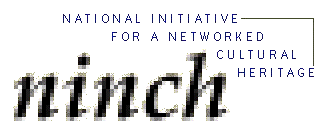
|
|
COMPUTER SCIENCE & THE HUMANITIES:CONFERENCE SERIES |
February 1999
This proposal originates from the Steering Committee for Computer Science and the Humanities. The committee, with representatives from the Computer Science and Telecommunications Board of the National Research Council; the Coalition for Networked Information; the American Council of Learned Societies; and the National Initiative for a Networked Cultural Heritage, has been convened to bring together stakeholders in the computer sciences and humanities communities to foster collaboration that promotes the application of information technology to the understanding of the human record.
A conference would be held annually for three years. This approach is modeled on the valuable experience conducted for five years (1991-96) jointly by the Association of Research Libraries (ARL) and the American Association of University Presses (AAUP). In a series of annual conferences, participants shared their experience and lessons learned (positive and negative) from projects underway. The program extrapolated from the participants' knowledge broader questions of usage, institutional needs and constraints, and the tensions between the communities of librarians and publishers. After five years, these shared conversations had established a high, common level of understanding and trust for future collaborations.
Conference goals will include:
A program committee composed of researchers and faculty in the field as well as representatives of the Steering Committee would select keynote speakers and panelists and develop criteria for selection of projects for breakout sessions and the project "fair." To avoid the "my database and I" approach of many conferences, which often entail descriptions of narrowly constrained niche applications, the program committee will look for new, proven, and emerging resources that have methodological significance.
This significance can be evident in two ways: the technologies in question can reveal or reinforce important aspects of traditional interpretative methods, or they may have potential to influence or alter received methods of teaching and research and challenge the prevailing disciplinary canon. The distinction between reinforced tradition and new or recombinant methodologies may, in some cases, be blurred in quite interesting fashion.
In either case, the program committee will ask conference participants to focus on the implications of the showcased projects, not just their technological components, as a means to enrich the understanding of these new tools and resources in the hope of advancing interdisciplinary collaboration.
Other selection criteria will include:
A annual conference of sustained activities which are routinely published, analyzed, and built upon, would enable those planning new projects in higher education to adjust their plans based on the experiences of others from year-to-year; establish trust and shared values as a base for future collaborations and policy-making among the constituencies served by the conference; inculcate technical standards; enable project planners to escape from single moment in technological developments; foster collaboration across humanities and computer science as a legitimate and necessary aspect of higher education.
DAY ONE |
DAY TWO | ||
|
AM |
PM |
AM |
PM |
|
Welcome |
Panel focusing on successful collaborations of various types (e.g., Living Cell, Carnegie-Mellon; Semantic Landscapes, Illinois at Urbana-Champaign)
|
Panel or keynote: : Salient changes in methodologies in the humanities |
Report on the NINCH/ACLS Building Blocks conferences and what their findings imply for future humanities/computer sciences projects
|
|
Keynote on the integration of humanities computing projects into the higher education infrastructure; connections between policy and program |
Project presentations (breakout sessions)
|
Panel on projects that did not work as planned (e.g., AALN; CETH) |
Small groups discuss and develop criteria and priorities for funding for use by funders, scholarly societies, and campuses
|
|
Project presentations [breakout sessions] e.g. AMICO; Internet Scout project; Optimization research |
Project fair |
Project presentations [breakout sessions]; (e.g., Valley of the Shadow, UVa; Imaging projects, Santa Cruz) )
|
Small groups report back to full group |
|
|
|
Panel or presentation on funding issues and charge to small groups
|
Wrap-up: Potential Areas of Most Productive Convergence of Humanities andComputer Science
|
The Steering Committee will establish a representative program committee which will assume responsibility for conference administration
The conference site should include a state-of-the-art facility where technology demonstrations (fair) could take place. Some suggested sites are Rice, Berkeley, U.Va., George Mason, Stanford, and Georgetown.
A dissemination committee would advise on the development of significant products and work with their constituencies to develop products that would be particularly effective with different audiences. Products might include:
The Steering Committee or Program Committee will develop an evaluation form to be completed by conference attendees. It will measure the perceived value of the conference and provide feedback on content or structural changes that might improve the program in the following year.